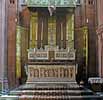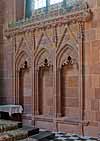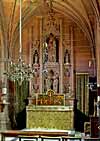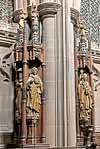For this church:    |
Clumber Park St MaryFeatures and Fittings
High AltarThe High Altar, which is raised on five steps, is of a white alabaster, with a relief of the Holy Mother, Jesus and two angels in the Nativity scene in the centre flanked by figures of adoring angels in panels holding scrolls all with a moulded plinth. These are interspersed by four niches with crocketed canopies containing shields with two types of sacred monogram with four quatrefoils beneath each shield. The top of the altar is of Frosterley marble carved with five crosses on top. The work was executed by the London company Messrs. Farmer and Brindley. The tall shelf above the altar is called the gradine and holds within the centre the Tabernacle, Flemish in style, which has a brass door decoration is in relief with a sacred monogram enclosed in a sunburst and beneath '.... panis angelorum' [behold the bread of angels]. The gradine was painted and gilded by Powingell of Lincoln, and the tabernacle executed by Barkentin and Krall of Regent Street, London. Both firms had worked with Bodley and his partner Thomas Garner on previous occasions. Sedilia
The red sandstone ashlars immediately to the south of the High Altar make up the triple sedilia, and above them flanked by the figures of two angels bearing sacred emblems are shown with different instruments of the Passion. A carpet in brown, red and blue wool stretches from the sanctuary towards the rood screen was made c.1880 by Watts and Co. Lady Chapel AltarThe altar and reredos in the Lady Chapel is of the rubic Runcorn stone. The lower part of the reredos details the Annunciation, and the upper part, the Virgin and Child. The traceried priest’s and choir stalls, the rood screen and the baptismal font cover are much adorned with groups of wood carvings to designs by the Rev Ernest Geldart who was engaged on the work following the quarrel and subsequent discharge of Bodley the architect. Stalls
The choir stalls were generally made in 1890 with the eastern blocks of stalls some thirty years later of richly decorated walnut and cedar maintaining a Gothic Revival style but with a more coarse approach and in some areas more elaborate than that of Bodley and are carved with sacred emblems, figures of saints and inscriptions. The four sections of the stalls each have three emblems, viz., the Fylfot, the Calvary and the monogram of the Sacred Name.
[Here may the heavenly watchers stand with us in line of battle];
[Let the Church show the joys of the eternal Mother];
[In this vale of suffering may the Mother help the daughter].
Statues in the ChoirThe columns of the par-close screen bays behind the stalls have well defined tiers of lime-wood statues representing the four Evangelists, the four Doctors [teachers] of the Western Church, the four Saints of Northern England, and four chief Archangels, all arranged in pairs with each section surmounted by groups of Angels. Considering the sections, representing the Evangelists and Doctors, nearer to the Rood Screen at the west end of the Choir; The southeast corner has the pair:
The southwest corner incorporates the pair:
The northwest corner pair:
And the northeast corner pair:

Considering now, the sections closer to the High Altar, representing the Saints of Northern England and the Archangels. The southwest corner pair of carvings:
The southeast corner pair:
In the northwest corner the pair appear as:
And in the northeast corner:
Within the niches to the front of the priests stalls are statues, carved in self finished walnut, which represent the six saints of the English Church. Considering the southern side, commencing from east though to the west:
The northern side, commencing in the west though to the east:
 St. Richard, holding a covered chalice. St. Richard, holding a covered chalice.
|
 Chancel screen, Chancel screen,and pulpit |
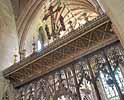 Detail of the chancel Detail of the chancelscreen showing the cornice and rood |
The dividing screen, constructed of oak, between the chancel and crossing designed by Bodley, supports an intricately carved cornice, necessary to stand six brass candlesticks, which illuminate the rood – the representation of the crucifixion.
The whole of the rood and its flanking figures of St. Mary and St. John are suspended from the chancel arch and were designed by Geldart, at the same time as the choir stalls, much to the deference of the original architects intension as depicted on H.W. Brewer’s architectural perspective watercolour drawing.
The screen gates are of wrought iron with quatrefoil decoration and castellated tops.
Pulpit
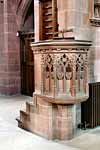 Pulpit Pulpit |
 Font Font |
The traceried panelled stone pulpit is erected on the buttress to the north end of the screen was a gift of the people of Worksop and was designed by Bodley.
This was originally fitted to the north-eastern corner of the nave, as depicted on H.W. Brewer’s perspective drawing and executed, as with most of the other stone carving, by the craftsmen of the London firm, Messrs. Farmer and Brindley.
Font
The baptistery holds the octagonal font, which has eight fine cedar panels and a cover, designed by the Rev Ernest Geldart. This was provided in the final scheme of furnishing the Chapel during 1912-22, depicting the Supreme Sacrifice and the Seven Sacraments, viz., Baptism, Confirmation, Holy Matrimony, the Holy Eucharist, Holy Orders, Absolution and Extreme Unction.
The pinnacle is surmounted by a pelican, which is the symbol of reincarnation.
Statues near the Font
 St John St Johnthe Baptist |
 St Mary St Mary the Virgin |
Supported on the north wall of this area, between the stained glass windows, is a painted plaster statue of St. John the Baptist, by John Ninian Comper.
The south passage has a similarly mounted painted carving, again by Comper, but on this occasion, depicts St. George and the Dragon.
The commission of Comper is not a surprise, firstly, his skill and attention to detail had become well known, and secondly, his background was such that having been raised in an atmosphere of lively and advanced Anglo-Catholicism, he would have had no problems in satisfying the Duke’s qualification. He was also articled for his training to C. E. Kempe, and later to Bodley and Garner.
The tower supporting column in the South Transept adjacent to the entrance into the Lady Chapel has attached another of Comper’s masterpieces, a painted and guilded plaster statue of St. Mary the Virgin with the Christ Child standing in gothic canopy with vaulted ceiling and crocketed pinnacles painted blue and gilded.
Lectern
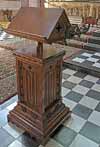 Lectern Lectern |
 Confessional Confessional box |
The oak lectern is somewhat portable and shares a place, according to season, on the chancel step or in the central crossing adjacent to the dividing screen on the opposite side to the pulpit. The Brewer perspective drawing clearly shows it positioned to the right in the crossing. The squared column base supports an elegant lectern slope with fitted and enclosed ends as designed by Bodley to which are fixed two incongruous black metal and copper sconces.
Confessional box
The gothic confessional box in the north transept has a wooden carved base with two detachable wooden carved angels on pinnacles. The door in the centre is in three pieces and there are two doors at the top and one at the bottom. Inside the confessional there are sliding doors for the priest to hear through and a wooden bench for the priest to sit on.
Stoups
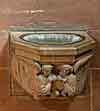 Holy water stoup Holy water stoup |
Holy water stoups were fitted in the north and south transepts late in the construction period of the external detailing work and are generally of stone with carvings of a pair of cherubs on the face, a timber trim and metal dish to the top.
Chandeliers and candle sconces
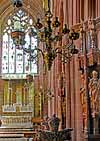 Chandelier Chandelier |
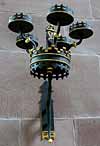 Candle sconce Candle sconce |
The chapel was originally lit by oil lamps and candles fitted into and onto various candle holders, some having several branches. The sconces are attached to the chapel walls and others directly onto items of furniture, such as the lectern.
Bodley, designed the Flemish style chandeliers and the wrought iron candle sconces placed throughout the chapel which were supplied by Messrs. Watts & Company of London. It should be noted this company was founded in association with Sir Gilbert Scott’s son Thomas Garner and George Frederick Bodley who became their first chairman. They provided embroidery, textiles, wallpaper, domestic furniture and metalwork.
Sanctuary lamps
A silver sanctuary lamp of Flemish design on three separate chains hangs on a brass and black and gold painted jointed shaft over the chancel sanctuary steps and is made up of five pieces. The lamp has a red glass vessel in the top which would have burnt all the time.
The silver hanging sanctuary lamp in the Lady Chapel is in three parts and supported on three chains with a brass pulley for lifting up or down. The chains are attached to the base by three small silver figures.
On the left of the altar in the Lady Chapel is a large gothic standing pyx of Belgian workmanship.
Paintings
Several paintings are hung within the chapel.
A late icon, which can be found above the credence table in the Lady Chapel. This was purchased by the 7th duke and fitted in the chapel in about 1892.
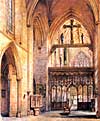 Nave and screen Nave and screen
by Brewer |
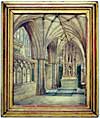 Lady Chapel Lady Chapel by Brewer |
Two architectural watercolours on paper of the internal areas of the chapel are now erected on the south wall of the Lady Chapel are both signed HWB, [Henry William Brewer (Oxford, 1836-1903)]. The style has much in similarity to his oil on canvas painting of the interior of the Dutch cathedral of Bois-le-Duc near Utrecht.
The first watercolour is a complete internal perspective drawing looking from the nave, over the crossing and rood, into the chancel. Certain differences can be observed which were actuated by later alterations, such as the movement of the Pulpit and slight changes in design. For example, the absence of the painted and gilded triptych of carved wood behind the altar, and the rood alternative construction. An insert of paper on the back of the picture reads R A Winter Exhibition.
The second watercolour depicts the Lady Chapel with all of its fine architectural detail as prescribed by Bodley but without furnishings cluttering the area.
Geldart provided on the walls of the nave and arcades in the duke’s final scheme of furnishing of the Chapel in 1912-22 a set of pictures depicting the thirteen Stations of the Cross; these are from late black on white paper 540 x 750mm German Gothic drawings.
Seating
Whilst the chancel is fully fitted with the respective choir and priest stalls which are noted elsewhere; the Lady Chapel incorporates separate seating.
The nave, however, is spartan in its provision with stone benches to the perimeter and loose temporary chairs being provided.
and child |
The west end corners have to the north a three quarters life size statue of Virgin and Child and in to the south a three quarters life size statue of St Joseph holding a set square in Limewood of Belgium origin standing on oak plinths and surrounds designed by the Rev E. Geldart.
Banner
 An Easter [Passover] banner in silk and gold thread with seven tassels can be noted also in the Lady Chapel and is of a processional type supported on an ebonized pole with brass and copper fittings. The cartoon depicts Christ in a gothic canoped niche with four angels with the inscription 'pascha nostri immolatus est Christus itaque epulemur' [Christ our passover is sacrificed for us, let us keep the feast].
An Easter [Passover] banner in silk and gold thread with seven tassels can be noted also in the Lady Chapel and is of a processional type supported on an ebonized pole with brass and copper fittings. The cartoon depicts Christ in a gothic canoped niche with four angels with the inscription 'pascha nostri immolatus est Christus itaque epulemur' [Christ our passover is sacrificed for us, let us keep the feast].
The catafalque funereal lamp standards placed within the Lady Chapel consist of a set of identical black catafalque lamps made of a twisted metal stem with a gilded star shape in centre, three black metal vine leaves under a drip tray and a circular base with gilding on a drip tray.


